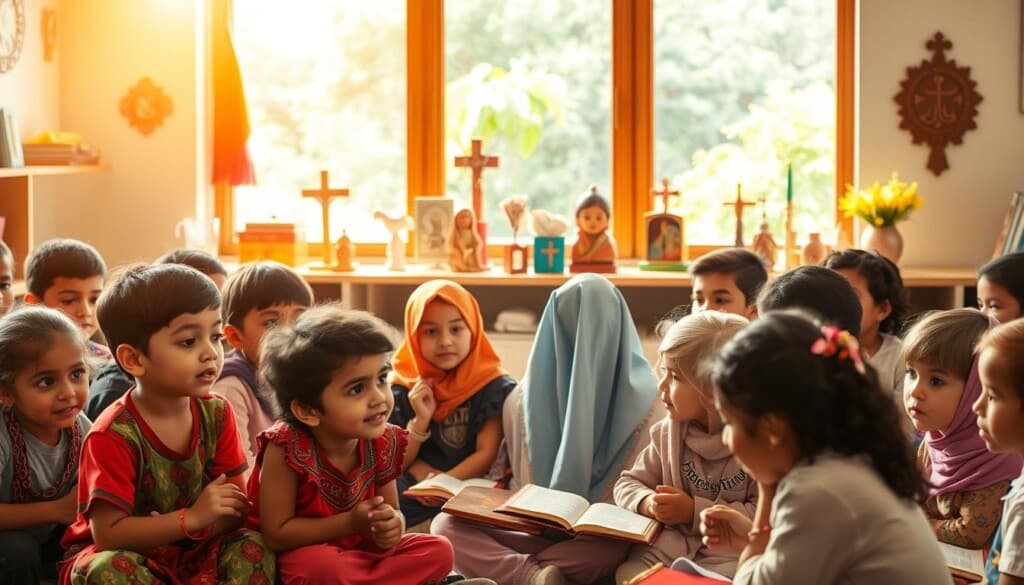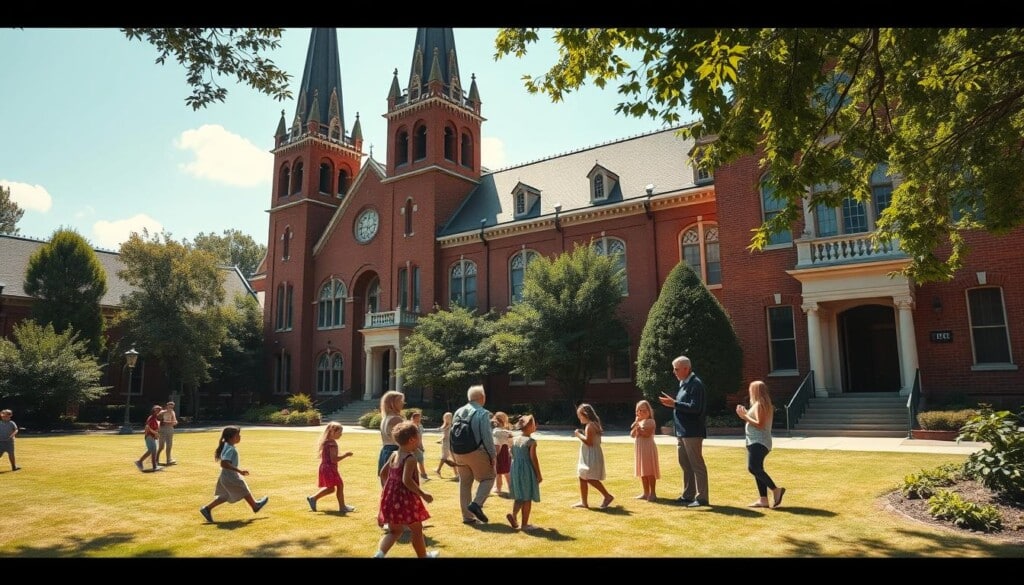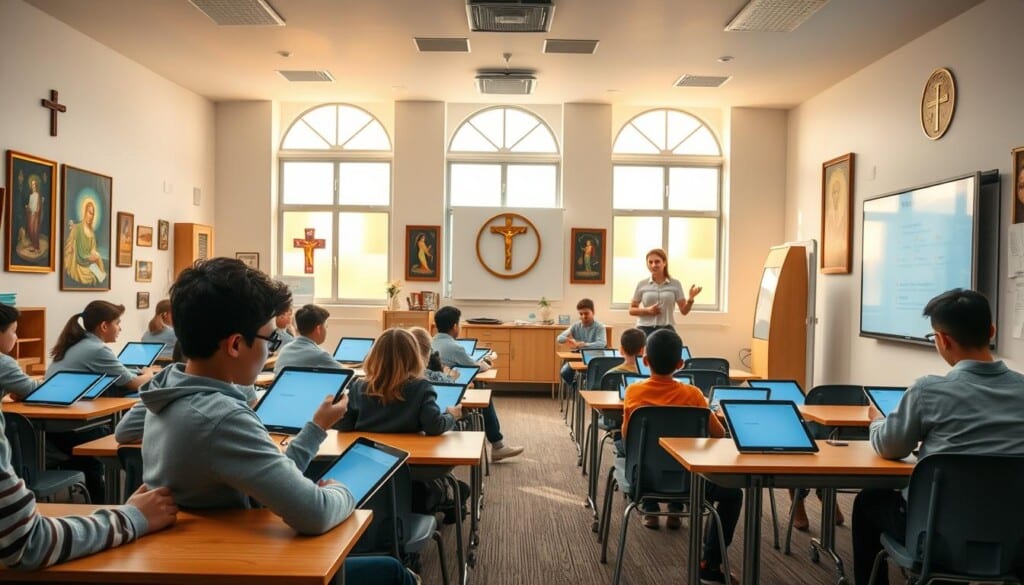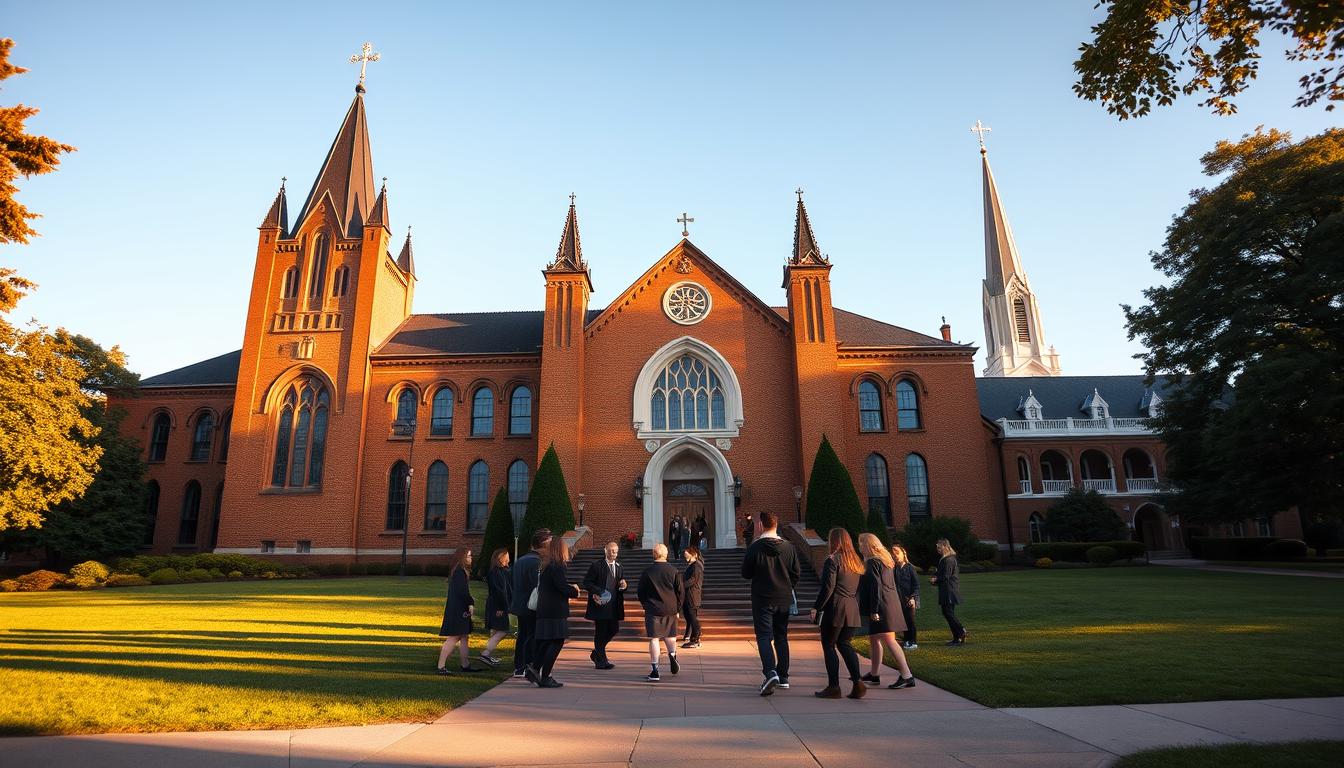Have you ever thought about how religious schools affect education and community values? This question leads us to look closer at faith-based schools and their big role in US education. These schools are more than just public school alternatives. They deeply influence cultural integration, academic success, and moral growth.
This article explores the beginnings and growth of private religious education. It highlights its historical importance and its ongoing impact in our diverse society today.
Key Takeaways
- Religious schools play a key role in promoting community values.
- Private religious education has a big impact on academic performance.
- The history of faith-based schools is complex and varied.
- Religious schools keep evolving to meet today’s educational needs.
- Getting involved in the community boosts the role of religious education.
- Understanding religious schools can change how we see education.
Understanding Religious Schools: A Historical Overview
The history of religious schools in America shows how faith and education merged over time. The early days of America saw settlers start schools focused on faith. These schools were the start of parochial schools, which grew to meet the need for religious education.
In the 20th century, big changes came with Supreme Court decisions. These rulings made public schools less religious, leading families to look at private schools. This led to many different religious schools, meeting the needs of American society.
Today, religious schools have changed a lot. They now welcome everyone and use new technology. They keep their faith but also offer a good education. This shows how faith and learning work together in today’s America.
Types of Religious Schools in the US
Religious schools in the United States are a big part of the education scene. They show a wide range of beliefs and traditions. Schools like Catholic, Protestant, and Jewish Day Schools offer unique ways to learn and grow spiritually.
Catholic Schools and Their Influence
Catholic Schools are a big deal in education, helping millions of students. They mix faith with learning, focusing on both knowledge and values. This helps students do well in life, showing the lasting impact of these schools.
Protestant Denominations and Their Educational Institutions
Protestant Schools come from different denominations, each with its own way of teaching. They teach Bible study and character, helping students grow in faith and knowledge. This variety helps students understand and respect different beliefs.
Jewish Day Schools and Their Contributions
Jewish Day Schools offer a special mix of learning and culture. They teach both secular and religious subjects, giving students a deep understanding of their heritage. This approach helps students grow both academically and spiritually, enriching the US education scene.

The Educational Framework of Religious Schools
Religious schools have a special way of teaching. They mix a detailed Religious School Curriculum with a focus on moral growth. This approach covers both school subjects and spiritual learning, creating a well-rounded education.
Curriculum Distinctions and Religious Instruction
These schools offer a unique mix of academic and religious studies. Students learn math and science, but also about their faith. This blend helps students understand both knowledge and spiritual values.
Focus on Moral and Ethical Development
Moral growth is key in religious schools. They teach values like respect, responsibility, and service. This helps students grow into caring citizens, ready to face life’s challenges with integrity.
Extracurricular Activities in Religious Schools
Outside the classroom, religious schools offer chances to apply faith in real life. Students can join community service, youth groups, or faith-based sports. These activities build teamwork, discipline, and a sense of community, teaching the value of giving back.
The Impact of Religious Schools on Academic Performance
Students in religious schools often do better in school than those in public schools. They tend to score higher on standardized tests. This shows that the special environments in these schools might help students succeed more.
This section looks at how test scores compare, what factors help students do well, and how parents play a role in education.
Comparing Test Scores: Religious vs. Public Schools
Studies show that students in religious schools usually do better than those in public schools. They often get higher scores on tests. This might be because of the better teaching methods and curricula in these schools.
These schools aim to teach well while also teaching values. This creates a great place for learning.
Factors Contributing to Higher Academic Achievement
Several things help students in religious schools do well. High standards and a strict environment push students to do their best. This helps them stay focused and behave better.
The teaching philosophy in these schools also encourages students to get involved. This helps them learn more and do better in school.
Parental Involvement and Student Success
Parents playing a big role in education is key. In religious schools, parents get involved in many ways. This helps students stay motivated and accountable.
These schools also focus on the whole child, not just their grades. This means families and teachers work together more. For more on helping in local education, check out LocalZ.
Social and Cultural Impact of Religious Schools
Religious schools play a key role in building community spirit. They bring students, families, and the community together. These schools are cultural centers, creating bonds that go beyond learning.
They offer a diverse setting where students from different backgrounds share their views. This makes learning richer and promotes unity.
Diversity is at the heart of religious schools, making them inclusive places. Here, every student is valued. This diversity broadens students’ views and builds respect among them.
These schools teach students to appreciate different perspectives. This helps in collaborative learning, where everyone benefits from each other’s ideas.
Religious schools also tackle social issues head-on. They teach students about social responsibility through community service and activism. This prepares them to be empathetic and responsible citizens.
Funding and Financial Considerations
Religious schools get money from different places like tuition, scholarships, and donations. The cost of tuition varies, with some schools being more affordable than others. Schools also count on community support to help fund their operations.
Tuition Models for Religious Schools
Many religious schools have flexible tuition plans. These plans help families with different budgets. By adjusting tuition based on income, schools make education more accessible. This approach helps schools stay stable and attract students from all walks of life.
Scholarships and Financial Aid Opportunities
Scholarships help families afford school. They make quality education more accessible. By having strong scholarship programs, schools can reach more families and grow their student body.
The Role of Donations and Fundraising
Donations are very important for religious schools. Money from alumni and the community helps improve education and facilities. Fundraising helps pay for extra programs and better buildings, making education better for everyone.

Working with local businesses and donors can help schools. Platforms like LocalZ can connect schools with people who want to help. This support is key for schools to thrive.
Challenges Facing Religious Schools Today
Religious schools face big challenges today. They struggle to follow rules while staying true to their faith. It’s hard to balance keeping up with educational standards and holding onto their unique values.
Regulatory Issues and Government Policies
Regulations can make things tough for religious schools. They must keep up with government policies that impact their teaching and funding. Following these rules can sometimes go against their beliefs and teaching methods.
It’s key to tackle these issues to keep their mission alive without losing educational quality.
Competition with Secular Educational Institutions
Religious schools also face stiff competition from secular schools. With more families seeing the benefits of public education, religious schools must stand out. They need to show how their values-based education is different and valuable.
It’s important to highlight their academic achievements and the unique learning experiences they offer.
Balancing Tradition with Modern Educational Needs
Religious schools must find a way to blend tradition with modern education. They need to use technology and make their curriculum more inclusive. As society changes, so do the expectations for schools.
They must adapt while staying true to their core values. This way, they can meet the needs of all their students.
The Role of Technology in Religious School Education
Technology has become key in religious schools today. Schools use digital tools to make learning more fun and interactive. This shift is essential for preparing students for the future.
Integrating Digital Tools into the Curriculum
Religious schools are now using digital tools in their lessons. They use apps, software, and multimedia to change old teaching ways. This makes learning more engaging and helps students learn at their own speed.
Online Learning Platforms and Their Benefits
Online platforms are changing how students learn. They offer flexibility, letting students study from anywhere. This helps schools reach more students and keeps them interested in learning.
Preparing Students for a Tech-Driven World
Students need to know how to use technology. Religious schools teach them digital skills. This prepares them for school and work in a world that’s all about tech.

Community Engagement Through Local Platforms
Community engagement is key for religious schools to thrive. LocalZ helps connect schools with their local communities. This boosts support for their educational efforts. It also creates partnerships that help both schools and local businesses.
How LocalZ Connects Religious Schools with Communities
LocalZ bridges the gap between schools and community members. It lets schools share their programs and events. This increases awareness and participation, making schools feel more connected to their communities.
Encouraging Local Business Support through Education
Local businesses and religious schools can benefit from working together. LocalZ helps set up these partnerships. This not only helps schools financially but also boosts the local economy. It’s a way for businesses to invest in their community’s future.
Collaborations between Schools and Local Organizations
Religious schools gain a lot from working with local organizations. LocalZ makes it easy to find these opportunities. Together, they can offer resources like volunteers, educational materials, and expertise. This way, communities can support schools and tackle bigger social issues.
Future Trends and Predictions for Religious Schools
The future of religious education is changing fast, thanks to new teaching methods. Hybrid models are becoming popular, mixing classroom learning with online options. This change helps schools reach more students and stay true to their values.
Growth of Hybrid Models and Innovations
Religious schools are using technology to improve learning. They’re combining traditional teaching with online tools. This makes learning more engaging and fits different learning styles. It helps schools meet the needs of today’s students.
Adapting to Changing Demographics
Religious schools are also changing how they reach out to students. They’re learning about the different backgrounds of their students. This helps schools make their programs more welcoming to all families.
The Importance of Mission-Driven Education in a Globalized World
In today’s world, mission-driven education is key. Religious schools need to share their values and meet educational needs. This way, they prepare students for local and global challenges. It builds a sense of community and moral strength.

